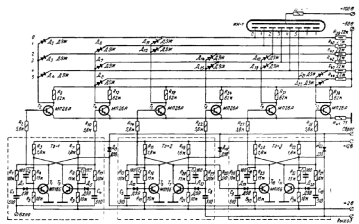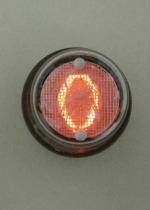
ИН-1in-1
|
|
|||||||||||||||||||||||||||||||
|
Hits: 11549 Replies: 13
in-1 (in-1) nixie tube, how to make a (decent) socket?
|
|
|
Marco Gilardetti
01.Mar.12 |
1
Good morning gentle fellows. I have recently purchased a bunch of IN-1 indicator tubes to be used in a display. I knew since the beginning that the original sockets are no longer available anywhere, but at sight I thought that the base was compatible with the Undecal receptacles used with some types of relais. Unfortunately it didn't come to my mind that russians NEVER did things the way they were made in the rest of the world ;-) so, although the pins are eleven and although there's the central plastic key, the tubes don't fit into Undecal sockets. Considered that many people here have impressive DIY skills, can perhaps anyone suggest some clever idea about how to make a decent-looking (seen from some distance ;-) socket that would fit IN-1 tubes? The tubes are very nice and it would be a pity to leave them unused. (Obviously I have already considered hard-wiring the tubes by soldering the leads directly to the pins, and decided that this is NOT an option, thank you). Of course, should anyone have some IN-1 socket in stock, I'm paying them well! Thanks for reading and have a nice day!
|
|
Michael Watterson
01.Mar.12 |
2
What size are the pins? Will they fit the RS232 / D-Connector type sockets? You can buy those separate from the shell.
Press 1n1 on paper to get a pattern. Get some Tufnol (1/3rd of socket length), or blank SRPB, or some layers of cheap SRPB or FR4 PCB (and take of copper) and cut blanks (perhaps oval to have two mounting holes. Make them fat enought for sockets by enough layers. Drill holes using paper guide Make holes in one layer bigger for catches on the push in sockets.
|
|
Marco Gilardetti
01.Mar.12 |
3
Michael, thanks for your answer. I can hardly understand your point, though. Isn't the connector you mention informatics stuff? |
|
Michael Watterson
01.Mar.12 |
4
The D-Connector shells or Molex connectors (larger pins) where you fit the desired number of contacts in the shell after crimping on the cable are an ideal source of physical individual sockets. You then drill holes of any quantity in 3 or 4 SRPB or Fibreglass or Tufnol blank sheets cut into ovals to make the overall socket. The one of the middle layers has slightly bigger holes drilled to allow the "catch" on the connector to lock in.
You don't need to crimp on wires. you can use them as regular solder or even clip them so they fit on PCB.
You can buy 100 sockets without the shells.
Molex connectors also have separately sold sockets in a range of sizes. |
|
Marco Gilardetti
01.Mar.12 |
5
Micheal, thanks for your entry, but... did you take a look at the tube? The pins are almost the same of those of an Octal socket, perhaps a bit wider. The pins of informatics connectors are thin as needles, I don't think they would fit! |
|
Michael Watterson
01.Mar.12 |
6
There are Molex sockets for the rectangular, square and round multipole connectors that work just the same. Some of those are as big as octal pins. The old 4 pin hard drive power connector is only one example, larger and smaller ones exist and socket connectors for the receptacles are sold in bags of 100.
|
|
Michael Watterson
01.Mar.12 |
7
If the pins are a bit larger than octal you can drill the pattern on a blank PCB and score the reverse track side into electrically isolated "lands". Then cut pieces of coffee tin a bit longer than the pin and cut 4 "fingers" and fold it on a small screwdriver to make a sprung socket. The "fingers" are bent out at 90 degrees and soldered to the PCB
Here is reverse side of a four way connector.
Below is a two way..
Outside of a three way
Cut strip a enough wider than pin length for "mounting fingers". Note depth of PCB reduces pin length. SRPB (illustrated) is easier to work with than FR4 (fibre glass). You can use a "Dremel" or do double scores with a knife and then heat the unwanted copper area with soldering iron to weaken glue and then peel off unwanted copper.
|
|
Marco Gilardetti
01.Mar.12 |
8
That sounds very promising indeed. Do you perhaps happen to know the code on the RS catalog of Molex female connectors that will fit Octal-sized pins? |
|
Emilio Ciardiello
01.Mar.12 |
9
Dear Marco, not sure of course, but give a look to the FAS045, an undecal socket for relays, at this site. Emilio |
|
Emilio Ciardiello
01.Mar.12 |
10
Of course, if the display fits the undecal base, any supplier of electro-mechanical relay should list it, including RS or Farnell. Emilio |
|
Michael Watterson
01.Mar.12 |
11
Of course the Vector rather than Raster 'Scope Clocks on "ask jan first" are amazing :-) (Google or other search of phrase in quotes brings the site 1st on list)
|
|
Marco Gilardetti
01.Mar.12 |
12
They are indeed, but I couldnt' find the suggested socket code throughout the website. However, as said in the starting post, standard Undecal sockets don't accept IN-1 tubes. I have a full box and made the experience directly. Micheal, do you happen to know which part code on the RS catalogue corresponds to the Molex female receptacle that will accept octal-sized pins? |
|
Michael Watterson
01.Mar.12 |
13
Sorry, I don't know. You'll have to measure your pin diameter and find the closest Molex socket from their data. They are slightly expandable, and also have a sprung contact so a slightly smaller or larger one will work.
|
|
Emilio Ciardiello
01.Mar.12 |
14
Dear Marco, the FAS045 can be found looking at the 'Catalogue' section, 'Tube accessories', 'Sockets, retainers and bases'. It is a long list and this code is almost at the end, just before the paragraph 'tube bases for rebasing and repair'. Else you can google the keywords 'undecal sockets': there are many sources for industrial relays. The difference is that the average sockets for industrial applications have screw terminals, while the type offered by 'Ask Jan first' is with soldering eyelets, similar to octal tube sockets. Emilio |
End of forum contributions about this tube
| Data Compliance | More Information |











